Circular Economy: Theoretical and Practical Perspectives with IKEA as a Case Study
VerifiedAdded on 2023/06/10
|17
|4327
|380
AI Summary
This report discusses the theoretical and practical perspectives of circular economy with IKEA as a case study. It covers the concepts and characteristics of circular economy, its main drivers, and its economic, social, and environmental benefits. It also explains the role of circular supply chain in business operations. The report concludes with the practical application of circular economy on IKEA's business model.
Contribute Materials
Your contribution can guide someone’s learning journey. Share your
documents today.
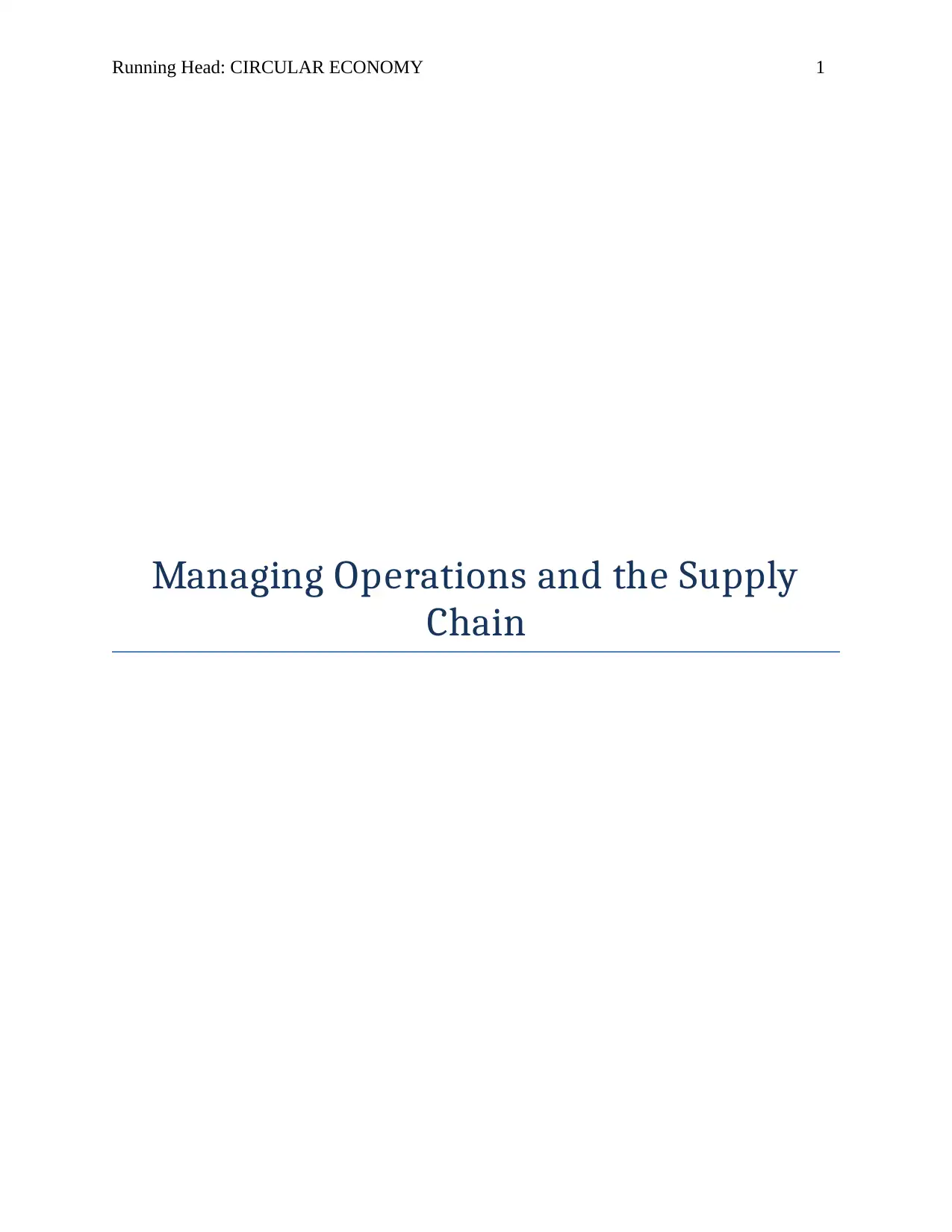
Running Head: CIRCULAR ECONOMY 1
Managing Operations and the Supply
Chain
Managing Operations and the Supply
Chain
Secure Best Marks with AI Grader
Need help grading? Try our AI Grader for instant feedback on your assignments.
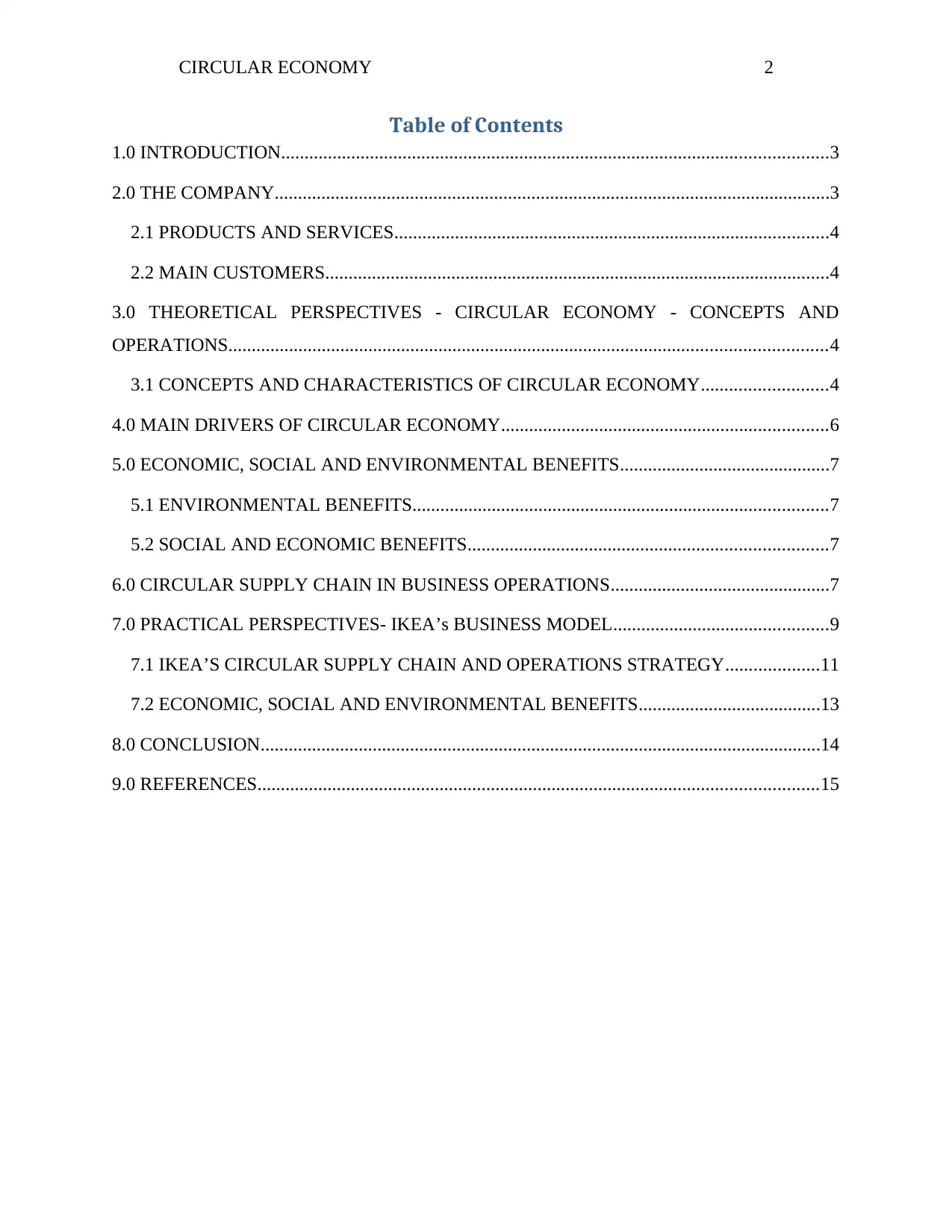
CIRCULAR ECONOMY 2
Table of Contents
1.0 INTRODUCTION.....................................................................................................................3
2.0 THE COMPANY.......................................................................................................................3
2.1 PRODUCTS AND SERVICES.............................................................................................4
2.2 MAIN CUSTOMERS............................................................................................................4
3.0 THEORETICAL PERSPECTIVES - CIRCULAR ECONOMY - CONCEPTS AND
OPERATIONS................................................................................................................................4
3.1 CONCEPTS AND CHARACTERISTICS OF CIRCULAR ECONOMY...........................4
4.0 MAIN DRIVERS OF CIRCULAR ECONOMY......................................................................6
5.0 ECONOMIC, SOCIAL AND ENVIRONMENTAL BENEFITS.............................................7
5.1 ENVIRONMENTAL BENEFITS.........................................................................................7
5.2 SOCIAL AND ECONOMIC BENEFITS.............................................................................7
6.0 CIRCULAR SUPPLY CHAIN IN BUSINESS OPERATIONS...............................................7
7.0 PRACTICAL PERSPECTIVES- IKEA’s BUSINESS MODEL..............................................9
7.1 IKEA’S CIRCULAR SUPPLY CHAIN AND OPERATIONS STRATEGY....................11
7.2 ECONOMIC, SOCIAL AND ENVIRONMENTAL BENEFITS.......................................13
8.0 CONCLUSION........................................................................................................................14
9.0 REFERENCES........................................................................................................................15
Table of Contents
1.0 INTRODUCTION.....................................................................................................................3
2.0 THE COMPANY.......................................................................................................................3
2.1 PRODUCTS AND SERVICES.............................................................................................4
2.2 MAIN CUSTOMERS............................................................................................................4
3.0 THEORETICAL PERSPECTIVES - CIRCULAR ECONOMY - CONCEPTS AND
OPERATIONS................................................................................................................................4
3.1 CONCEPTS AND CHARACTERISTICS OF CIRCULAR ECONOMY...........................4
4.0 MAIN DRIVERS OF CIRCULAR ECONOMY......................................................................6
5.0 ECONOMIC, SOCIAL AND ENVIRONMENTAL BENEFITS.............................................7
5.1 ENVIRONMENTAL BENEFITS.........................................................................................7
5.2 SOCIAL AND ECONOMIC BENEFITS.............................................................................7
6.0 CIRCULAR SUPPLY CHAIN IN BUSINESS OPERATIONS...............................................7
7.0 PRACTICAL PERSPECTIVES- IKEA’s BUSINESS MODEL..............................................9
7.1 IKEA’S CIRCULAR SUPPLY CHAIN AND OPERATIONS STRATEGY....................11
7.2 ECONOMIC, SOCIAL AND ENVIRONMENTAL BENEFITS.......................................13
8.0 CONCLUSION........................................................................................................................14
9.0 REFERENCES........................................................................................................................15
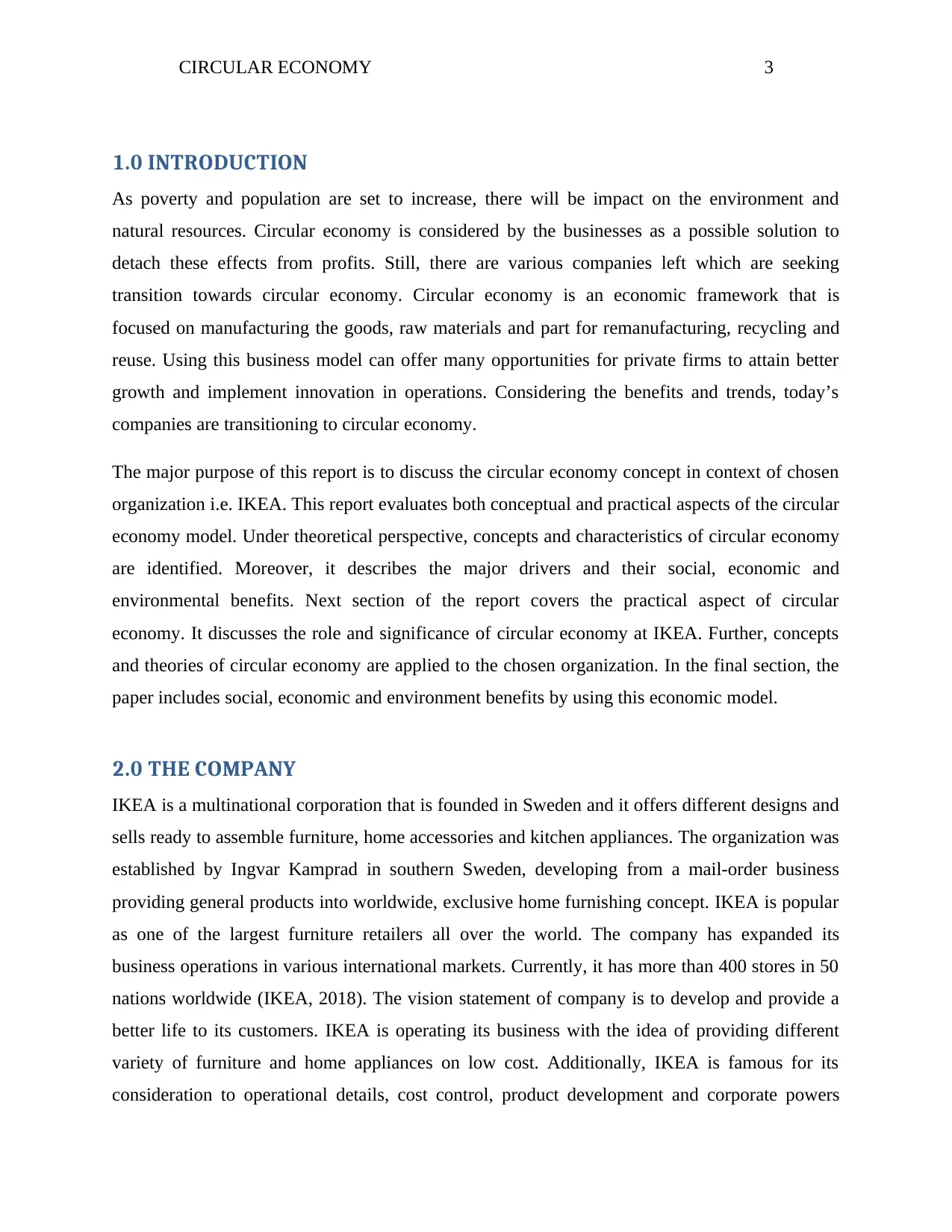
CIRCULAR ECONOMY 3
1.0 INTRODUCTION
As poverty and population are set to increase, there will be impact on the environment and
natural resources. Circular economy is considered by the businesses as a possible solution to
detach these effects from profits. Still, there are various companies left which are seeking
transition towards circular economy. Circular economy is an economic framework that is
focused on manufacturing the goods, raw materials and part for remanufacturing, recycling and
reuse. Using this business model can offer many opportunities for private firms to attain better
growth and implement innovation in operations. Considering the benefits and trends, today’s
companies are transitioning to circular economy.
The major purpose of this report is to discuss the circular economy concept in context of chosen
organization i.e. IKEA. This report evaluates both conceptual and practical aspects of the circular
economy model. Under theoretical perspective, concepts and characteristics of circular economy
are identified. Moreover, it describes the major drivers and their social, economic and
environmental benefits. Next section of the report covers the practical aspect of circular
economy. It discusses the role and significance of circular economy at IKEA. Further, concepts
and theories of circular economy are applied to the chosen organization. In the final section, the
paper includes social, economic and environment benefits by using this economic model.
2.0 THE COMPANY
IKEA is a multinational corporation that is founded in Sweden and it offers different designs and
sells ready to assemble furniture, home accessories and kitchen appliances. The organization was
established by Ingvar Kamprad in southern Sweden, developing from a mail-order business
providing general products into worldwide, exclusive home furnishing concept. IKEA is popular
as one of the largest furniture retailers all over the world. The company has expanded its
business operations in various international markets. Currently, it has more than 400 stores in 50
nations worldwide (IKEA, 2018). The vision statement of company is to develop and provide a
better life to its customers. IKEA is operating its business with the idea of providing different
variety of furniture and home appliances on low cost. Additionally, IKEA is famous for its
consideration to operational details, cost control, product development and corporate powers
1.0 INTRODUCTION
As poverty and population are set to increase, there will be impact on the environment and
natural resources. Circular economy is considered by the businesses as a possible solution to
detach these effects from profits. Still, there are various companies left which are seeking
transition towards circular economy. Circular economy is an economic framework that is
focused on manufacturing the goods, raw materials and part for remanufacturing, recycling and
reuse. Using this business model can offer many opportunities for private firms to attain better
growth and implement innovation in operations. Considering the benefits and trends, today’s
companies are transitioning to circular economy.
The major purpose of this report is to discuss the circular economy concept in context of chosen
organization i.e. IKEA. This report evaluates both conceptual and practical aspects of the circular
economy model. Under theoretical perspective, concepts and characteristics of circular economy
are identified. Moreover, it describes the major drivers and their social, economic and
environmental benefits. Next section of the report covers the practical aspect of circular
economy. It discusses the role and significance of circular economy at IKEA. Further, concepts
and theories of circular economy are applied to the chosen organization. In the final section, the
paper includes social, economic and environment benefits by using this economic model.
2.0 THE COMPANY
IKEA is a multinational corporation that is founded in Sweden and it offers different designs and
sells ready to assemble furniture, home accessories and kitchen appliances. The organization was
established by Ingvar Kamprad in southern Sweden, developing from a mail-order business
providing general products into worldwide, exclusive home furnishing concept. IKEA is popular
as one of the largest furniture retailers all over the world. The company has expanded its
business operations in various international markets. Currently, it has more than 400 stores in 50
nations worldwide (IKEA, 2018). The vision statement of company is to develop and provide a
better life to its customers. IKEA is operating its business with the idea of providing different
variety of furniture and home appliances on low cost. Additionally, IKEA is famous for its
consideration to operational details, cost control, product development and corporate powers
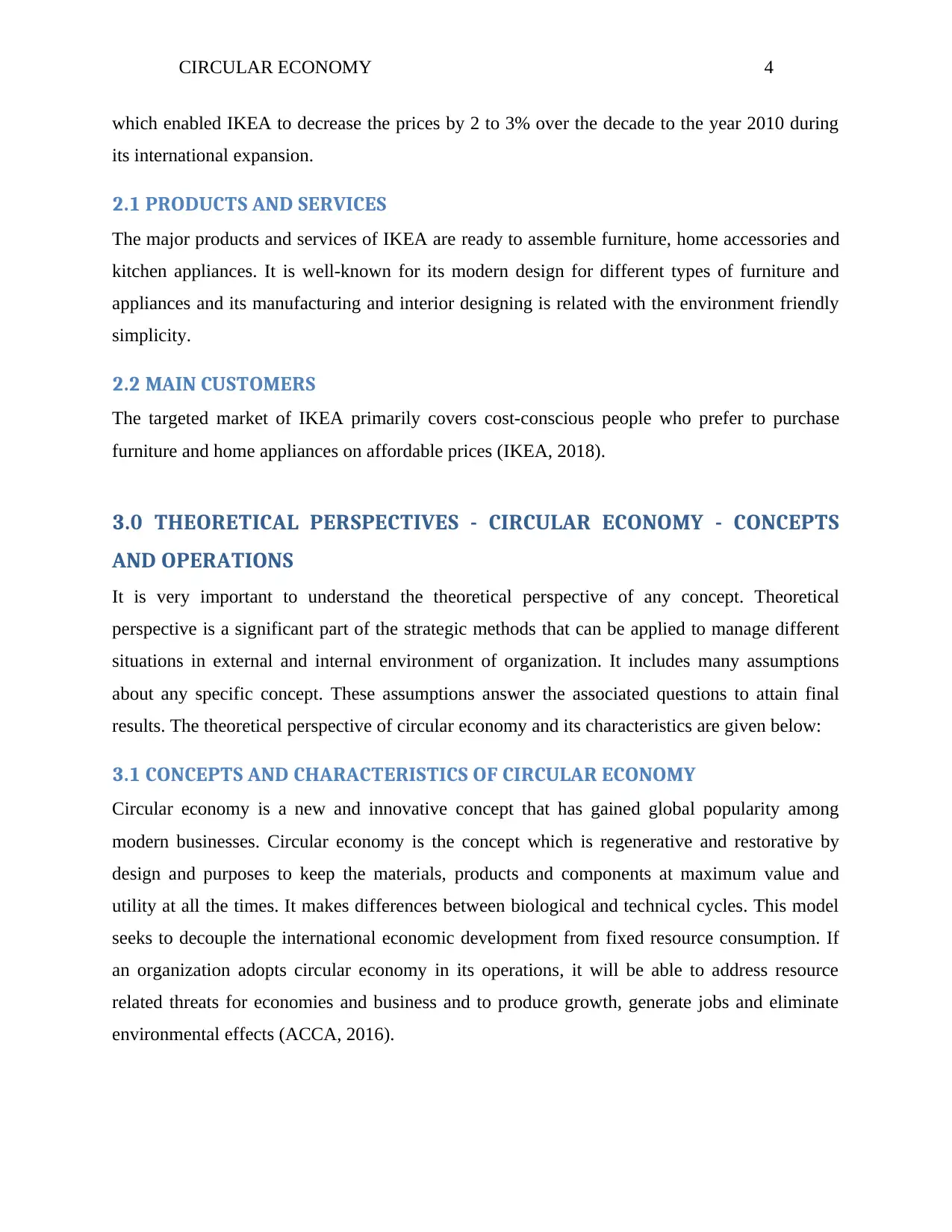
CIRCULAR ECONOMY 4
which enabled IKEA to decrease the prices by 2 to 3% over the decade to the year 2010 during
its international expansion.
2.1 PRODUCTS AND SERVICES
The major products and services of IKEA are ready to assemble furniture, home accessories and
kitchen appliances. It is well-known for its modern design for different types of furniture and
appliances and its manufacturing and interior designing is related with the environment friendly
simplicity.
2.2 MAIN CUSTOMERS
The targeted market of IKEA primarily covers cost-conscious people who prefer to purchase
furniture and home appliances on affordable prices (IKEA, 2018).
3.0 THEORETICAL PERSPECTIVES - CIRCULAR ECONOMY - CONCEPTS
AND OPERATIONS
It is very important to understand the theoretical perspective of any concept. Theoretical
perspective is a significant part of the strategic methods that can be applied to manage different
situations in external and internal environment of organization. It includes many assumptions
about any specific concept. These assumptions answer the associated questions to attain final
results. The theoretical perspective of circular economy and its characteristics are given below:
3.1 CONCEPTS AND CHARACTERISTICS OF CIRCULAR ECONOMY
Circular economy is a new and innovative concept that has gained global popularity among
modern businesses. Circular economy is the concept which is regenerative and restorative by
design and purposes to keep the materials, products and components at maximum value and
utility at all the times. It makes differences between biological and technical cycles. This model
seeks to decouple the international economic development from fixed resource consumption. If
an organization adopts circular economy in its operations, it will be able to address resource
related threats for economies and business and to produce growth, generate jobs and eliminate
environmental effects (ACCA, 2016).
which enabled IKEA to decrease the prices by 2 to 3% over the decade to the year 2010 during
its international expansion.
2.1 PRODUCTS AND SERVICES
The major products and services of IKEA are ready to assemble furniture, home accessories and
kitchen appliances. It is well-known for its modern design for different types of furniture and
appliances and its manufacturing and interior designing is related with the environment friendly
simplicity.
2.2 MAIN CUSTOMERS
The targeted market of IKEA primarily covers cost-conscious people who prefer to purchase
furniture and home appliances on affordable prices (IKEA, 2018).
3.0 THEORETICAL PERSPECTIVES - CIRCULAR ECONOMY - CONCEPTS
AND OPERATIONS
It is very important to understand the theoretical perspective of any concept. Theoretical
perspective is a significant part of the strategic methods that can be applied to manage different
situations in external and internal environment of organization. It includes many assumptions
about any specific concept. These assumptions answer the associated questions to attain final
results. The theoretical perspective of circular economy and its characteristics are given below:
3.1 CONCEPTS AND CHARACTERISTICS OF CIRCULAR ECONOMY
Circular economy is a new and innovative concept that has gained global popularity among
modern businesses. Circular economy is the concept which is regenerative and restorative by
design and purposes to keep the materials, products and components at maximum value and
utility at all the times. It makes differences between biological and technical cycles. This model
seeks to decouple the international economic development from fixed resource consumption. If
an organization adopts circular economy in its operations, it will be able to address resource
related threats for economies and business and to produce growth, generate jobs and eliminate
environmental effects (ACCA, 2016).
Secure Best Marks with AI Grader
Need help grading? Try our AI Grader for instant feedback on your assignments.
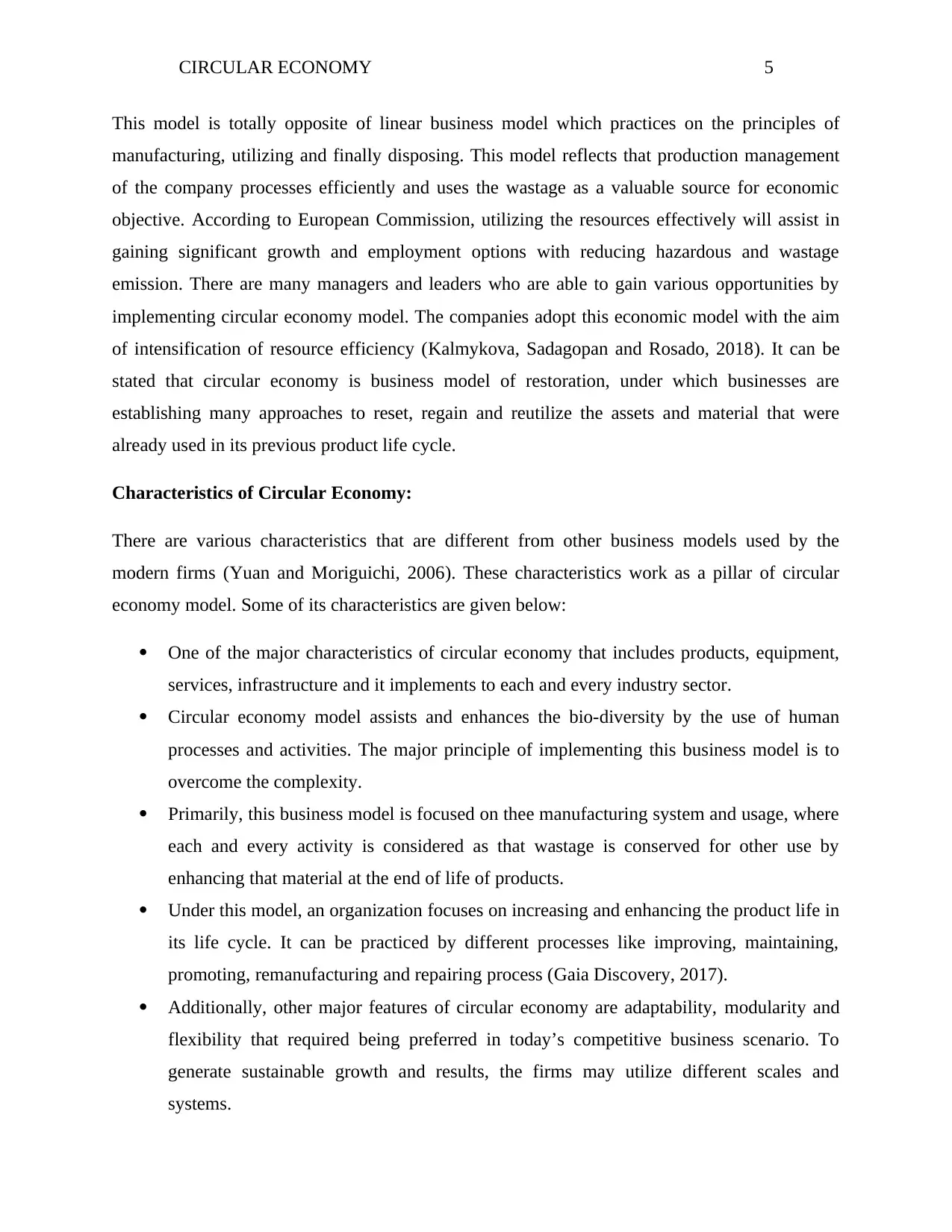
CIRCULAR ECONOMY 5
This model is totally opposite of linear business model which practices on the principles of
manufacturing, utilizing and finally disposing. This model reflects that production management
of the company processes efficiently and uses the wastage as a valuable source for economic
objective. According to European Commission, utilizing the resources effectively will assist in
gaining significant growth and employment options with reducing hazardous and wastage
emission. There are many managers and leaders who are able to gain various opportunities by
implementing circular economy model. The companies adopt this economic model with the aim
of intensification of resource efficiency (Kalmykova, Sadagopan and Rosado, 2018). It can be
stated that circular economy is business model of restoration, under which businesses are
establishing many approaches to reset, regain and reutilize the assets and material that were
already used in its previous product life cycle.
Characteristics of Circular Economy:
There are various characteristics that are different from other business models used by the
modern firms (Yuan and Moriguichi, 2006). These characteristics work as a pillar of circular
economy model. Some of its characteristics are given below:
One of the major characteristics of circular economy that includes products, equipment,
services, infrastructure and it implements to each and every industry sector.
Circular economy model assists and enhances the bio-diversity by the use of human
processes and activities. The major principle of implementing this business model is to
overcome the complexity.
Primarily, this business model is focused on thee manufacturing system and usage, where
each and every activity is considered as that wastage is conserved for other use by
enhancing that material at the end of life of products.
Under this model, an organization focuses on increasing and enhancing the product life in
its life cycle. It can be practiced by different processes like improving, maintaining,
promoting, remanufacturing and repairing process (Gaia Discovery, 2017).
Additionally, other major features of circular economy are adaptability, modularity and
flexibility that required being preferred in today’s competitive business scenario. To
generate sustainable growth and results, the firms may utilize different scales and
systems.
This model is totally opposite of linear business model which practices on the principles of
manufacturing, utilizing and finally disposing. This model reflects that production management
of the company processes efficiently and uses the wastage as a valuable source for economic
objective. According to European Commission, utilizing the resources effectively will assist in
gaining significant growth and employment options with reducing hazardous and wastage
emission. There are many managers and leaders who are able to gain various opportunities by
implementing circular economy model. The companies adopt this economic model with the aim
of intensification of resource efficiency (Kalmykova, Sadagopan and Rosado, 2018). It can be
stated that circular economy is business model of restoration, under which businesses are
establishing many approaches to reset, regain and reutilize the assets and material that were
already used in its previous product life cycle.
Characteristics of Circular Economy:
There are various characteristics that are different from other business models used by the
modern firms (Yuan and Moriguichi, 2006). These characteristics work as a pillar of circular
economy model. Some of its characteristics are given below:
One of the major characteristics of circular economy that includes products, equipment,
services, infrastructure and it implements to each and every industry sector.
Circular economy model assists and enhances the bio-diversity by the use of human
processes and activities. The major principle of implementing this business model is to
overcome the complexity.
Primarily, this business model is focused on thee manufacturing system and usage, where
each and every activity is considered as that wastage is conserved for other use by
enhancing that material at the end of life of products.
Under this model, an organization focuses on increasing and enhancing the product life in
its life cycle. It can be practiced by different processes like improving, maintaining,
promoting, remanufacturing and repairing process (Gaia Discovery, 2017).
Additionally, other major features of circular economy are adaptability, modularity and
flexibility that required being preferred in today’s competitive business scenario. To
generate sustainable growth and results, the firms may utilize different scales and
systems.
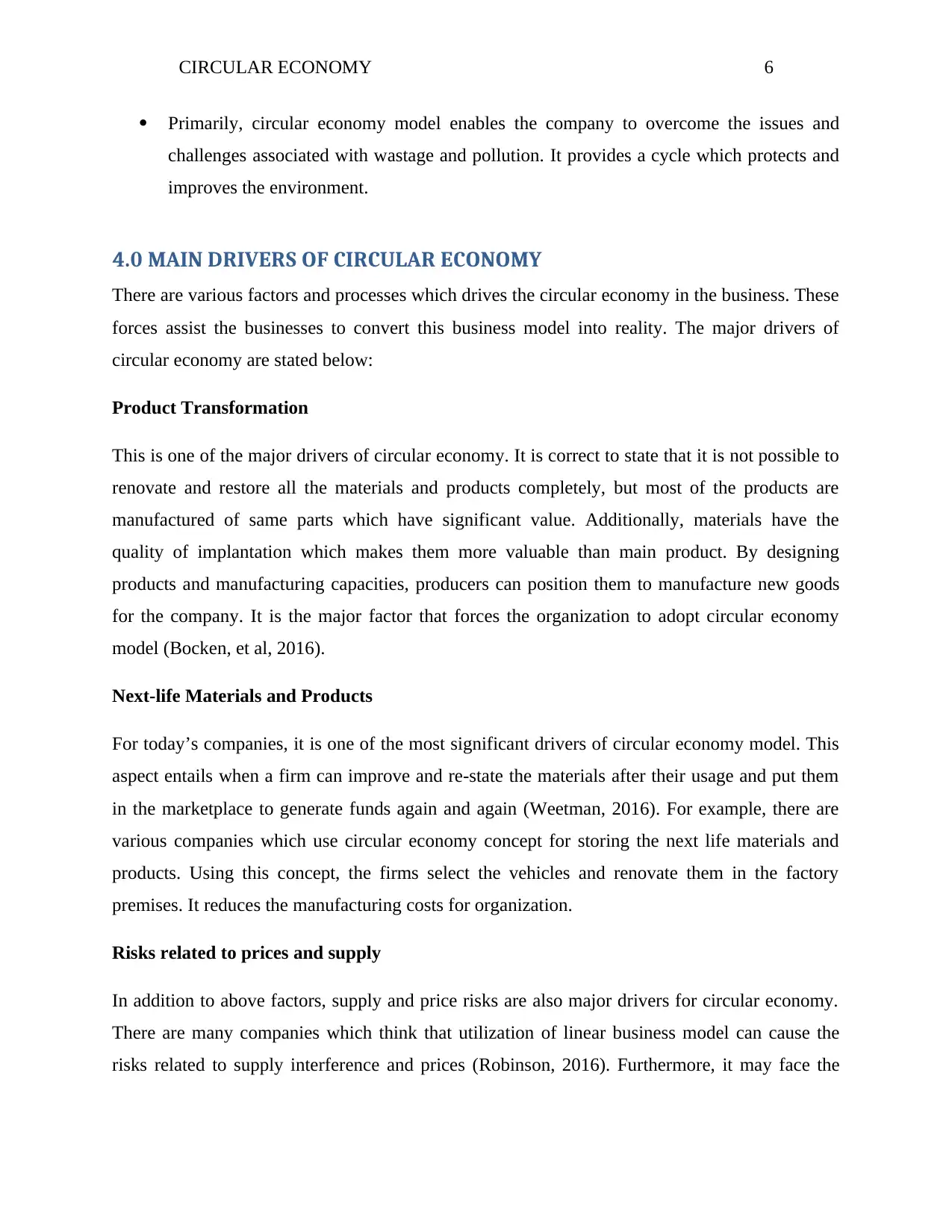
CIRCULAR ECONOMY 6
Primarily, circular economy model enables the company to overcome the issues and
challenges associated with wastage and pollution. It provides a cycle which protects and
improves the environment.
4.0 MAIN DRIVERS OF CIRCULAR ECONOMY
There are various factors and processes which drives the circular economy in the business. These
forces assist the businesses to convert this business model into reality. The major drivers of
circular economy are stated below:
Product Transformation
This is one of the major drivers of circular economy. It is correct to state that it is not possible to
renovate and restore all the materials and products completely, but most of the products are
manufactured of same parts which have significant value. Additionally, materials have the
quality of implantation which makes them more valuable than main product. By designing
products and manufacturing capacities, producers can position them to manufacture new goods
for the company. It is the major factor that forces the organization to adopt circular economy
model (Bocken, et al, 2016).
Next-life Materials and Products
For today’s companies, it is one of the most significant drivers of circular economy model. This
aspect entails when a firm can improve and re-state the materials after their usage and put them
in the marketplace to generate funds again and again (Weetman, 2016). For example, there are
various companies which use circular economy concept for storing the next life materials and
products. Using this concept, the firms select the vehicles and renovate them in the factory
premises. It reduces the manufacturing costs for organization.
Risks related to prices and supply
In addition to above factors, supply and price risks are also major drivers for circular economy.
There are many companies which think that utilization of linear business model can cause the
risks related to supply interference and prices (Robinson, 2016). Furthermore, it may face the
Primarily, circular economy model enables the company to overcome the issues and
challenges associated with wastage and pollution. It provides a cycle which protects and
improves the environment.
4.0 MAIN DRIVERS OF CIRCULAR ECONOMY
There are various factors and processes which drives the circular economy in the business. These
forces assist the businesses to convert this business model into reality. The major drivers of
circular economy are stated below:
Product Transformation
This is one of the major drivers of circular economy. It is correct to state that it is not possible to
renovate and restore all the materials and products completely, but most of the products are
manufactured of same parts which have significant value. Additionally, materials have the
quality of implantation which makes them more valuable than main product. By designing
products and manufacturing capacities, producers can position them to manufacture new goods
for the company. It is the major factor that forces the organization to adopt circular economy
model (Bocken, et al, 2016).
Next-life Materials and Products
For today’s companies, it is one of the most significant drivers of circular economy model. This
aspect entails when a firm can improve and re-state the materials after their usage and put them
in the marketplace to generate funds again and again (Weetman, 2016). For example, there are
various companies which use circular economy concept for storing the next life materials and
products. Using this concept, the firms select the vehicles and renovate them in the factory
premises. It reduces the manufacturing costs for organization.
Risks related to prices and supply
In addition to above factors, supply and price risks are also major drivers for circular economy.
There are many companies which think that utilization of linear business model can cause the
risks related to supply interference and prices (Robinson, 2016). Furthermore, it may face the
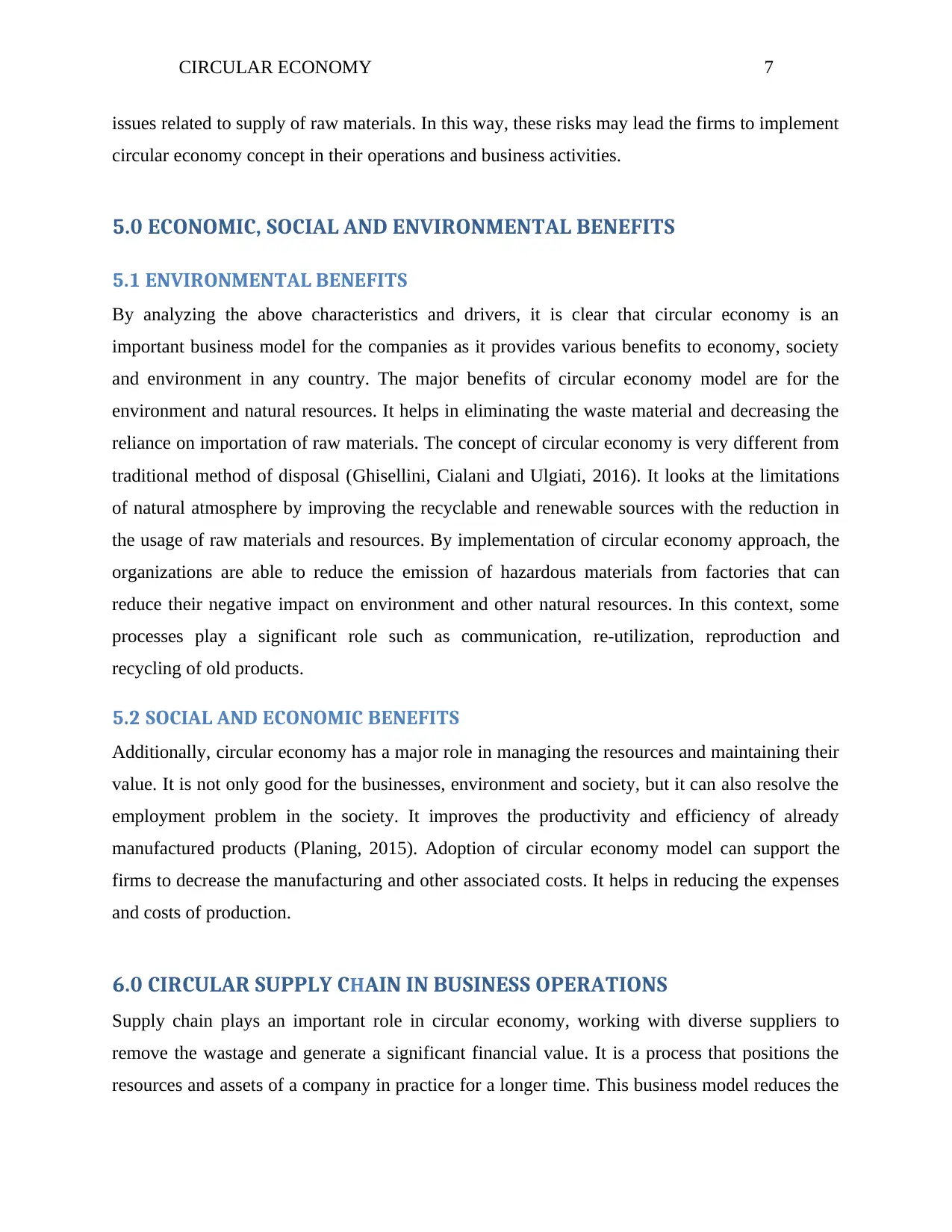
CIRCULAR ECONOMY 7
issues related to supply of raw materials. In this way, these risks may lead the firms to implement
circular economy concept in their operations and business activities.
5.0 ECONOMIC, SOCIAL AND ENVIRONMENTAL BENEFITS
5.1 ENVIRONMENTAL BENEFITS
By analyzing the above characteristics and drivers, it is clear that circular economy is an
important business model for the companies as it provides various benefits to economy, society
and environment in any country. The major benefits of circular economy model are for the
environment and natural resources. It helps in eliminating the waste material and decreasing the
reliance on importation of raw materials. The concept of circular economy is very different from
traditional method of disposal (Ghisellini, Cialani and Ulgiati, 2016). It looks at the limitations
of natural atmosphere by improving the recyclable and renewable sources with the reduction in
the usage of raw materials and resources. By implementation of circular economy approach, the
organizations are able to reduce the emission of hazardous materials from factories that can
reduce their negative impact on environment and other natural resources. In this context, some
processes play a significant role such as communication, re-utilization, reproduction and
recycling of old products.
5.2 SOCIAL AND ECONOMIC BENEFITS
Additionally, circular economy has a major role in managing the resources and maintaining their
value. It is not only good for the businesses, environment and society, but it can also resolve the
employment problem in the society. It improves the productivity and efficiency of already
manufactured products (Planing, 2015). Adoption of circular economy model can support the
firms to decrease the manufacturing and other associated costs. It helps in reducing the expenses
and costs of production.
6.0 CIRCULAR SUPPLY CHAIN IN BUSINESS OPERATIONS
Supply chain plays an important role in circular economy, working with diverse suppliers to
remove the wastage and generate a significant financial value. It is a process that positions the
resources and assets of a company in practice for a longer time. This business model reduces the
issues related to supply of raw materials. In this way, these risks may lead the firms to implement
circular economy concept in their operations and business activities.
5.0 ECONOMIC, SOCIAL AND ENVIRONMENTAL BENEFITS
5.1 ENVIRONMENTAL BENEFITS
By analyzing the above characteristics and drivers, it is clear that circular economy is an
important business model for the companies as it provides various benefits to economy, society
and environment in any country. The major benefits of circular economy model are for the
environment and natural resources. It helps in eliminating the waste material and decreasing the
reliance on importation of raw materials. The concept of circular economy is very different from
traditional method of disposal (Ghisellini, Cialani and Ulgiati, 2016). It looks at the limitations
of natural atmosphere by improving the recyclable and renewable sources with the reduction in
the usage of raw materials and resources. By implementation of circular economy approach, the
organizations are able to reduce the emission of hazardous materials from factories that can
reduce their negative impact on environment and other natural resources. In this context, some
processes play a significant role such as communication, re-utilization, reproduction and
recycling of old products.
5.2 SOCIAL AND ECONOMIC BENEFITS
Additionally, circular economy has a major role in managing the resources and maintaining their
value. It is not only good for the businesses, environment and society, but it can also resolve the
employment problem in the society. It improves the productivity and efficiency of already
manufactured products (Planing, 2015). Adoption of circular economy model can support the
firms to decrease the manufacturing and other associated costs. It helps in reducing the expenses
and costs of production.
6.0 CIRCULAR SUPPLY CHAIN IN BUSINESS OPERATIONS
Supply chain plays an important role in circular economy, working with diverse suppliers to
remove the wastage and generate a significant financial value. It is a process that positions the
resources and assets of a company in practice for a longer time. This business model reduces the
Paraphrase This Document
Need a fresh take? Get an instant paraphrase of this document with our AI Paraphraser
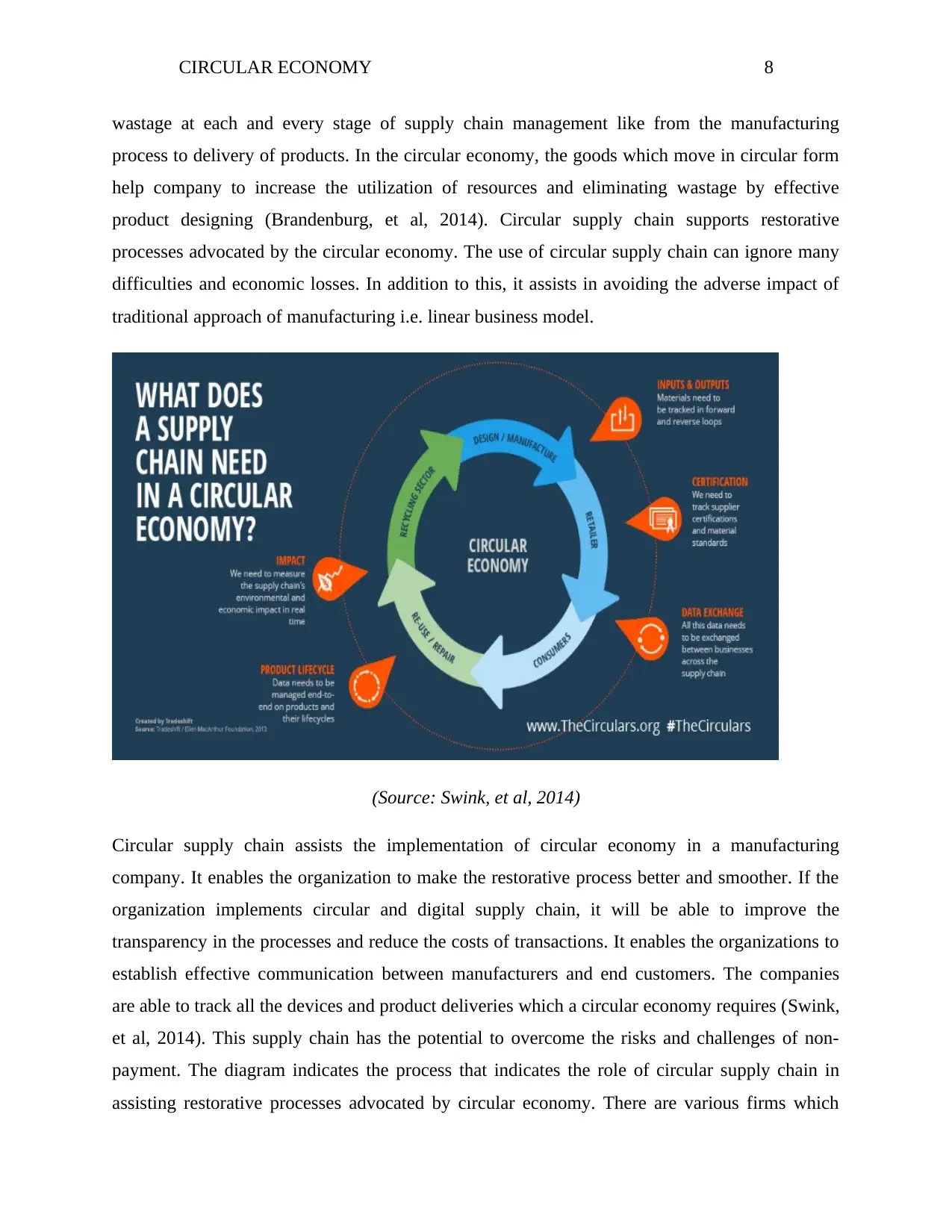
CIRCULAR ECONOMY 8
wastage at each and every stage of supply chain management like from the manufacturing
process to delivery of products. In the circular economy, the goods which move in circular form
help company to increase the utilization of resources and eliminating wastage by effective
product designing (Brandenburg, et al, 2014). Circular supply chain supports restorative
processes advocated by the circular economy. The use of circular supply chain can ignore many
difficulties and economic losses. In addition to this, it assists in avoiding the adverse impact of
traditional approach of manufacturing i.e. linear business model.
(Source: Swink, et al, 2014)
Circular supply chain assists the implementation of circular economy in a manufacturing
company. It enables the organization to make the restorative process better and smoother. If the
organization implements circular and digital supply chain, it will be able to improve the
transparency in the processes and reduce the costs of transactions. It enables the organizations to
establish effective communication between manufacturers and end customers. The companies
are able to track all the devices and product deliveries which a circular economy requires (Swink,
et al, 2014). This supply chain has the potential to overcome the risks and challenges of non-
payment. The diagram indicates the process that indicates the role of circular supply chain in
assisting restorative processes advocated by circular economy. There are various firms which
wastage at each and every stage of supply chain management like from the manufacturing
process to delivery of products. In the circular economy, the goods which move in circular form
help company to increase the utilization of resources and eliminating wastage by effective
product designing (Brandenburg, et al, 2014). Circular supply chain supports restorative
processes advocated by the circular economy. The use of circular supply chain can ignore many
difficulties and economic losses. In addition to this, it assists in avoiding the adverse impact of
traditional approach of manufacturing i.e. linear business model.
(Source: Swink, et al, 2014)
Circular supply chain assists the implementation of circular economy in a manufacturing
company. It enables the organization to make the restorative process better and smoother. If the
organization implements circular and digital supply chain, it will be able to improve the
transparency in the processes and reduce the costs of transactions. It enables the organizations to
establish effective communication between manufacturers and end customers. The companies
are able to track all the devices and product deliveries which a circular economy requires (Swink,
et al, 2014). This supply chain has the potential to overcome the risks and challenges of non-
payment. The diagram indicates the process that indicates the role of circular supply chain in
assisting restorative processes advocated by circular economy. There are various firms which
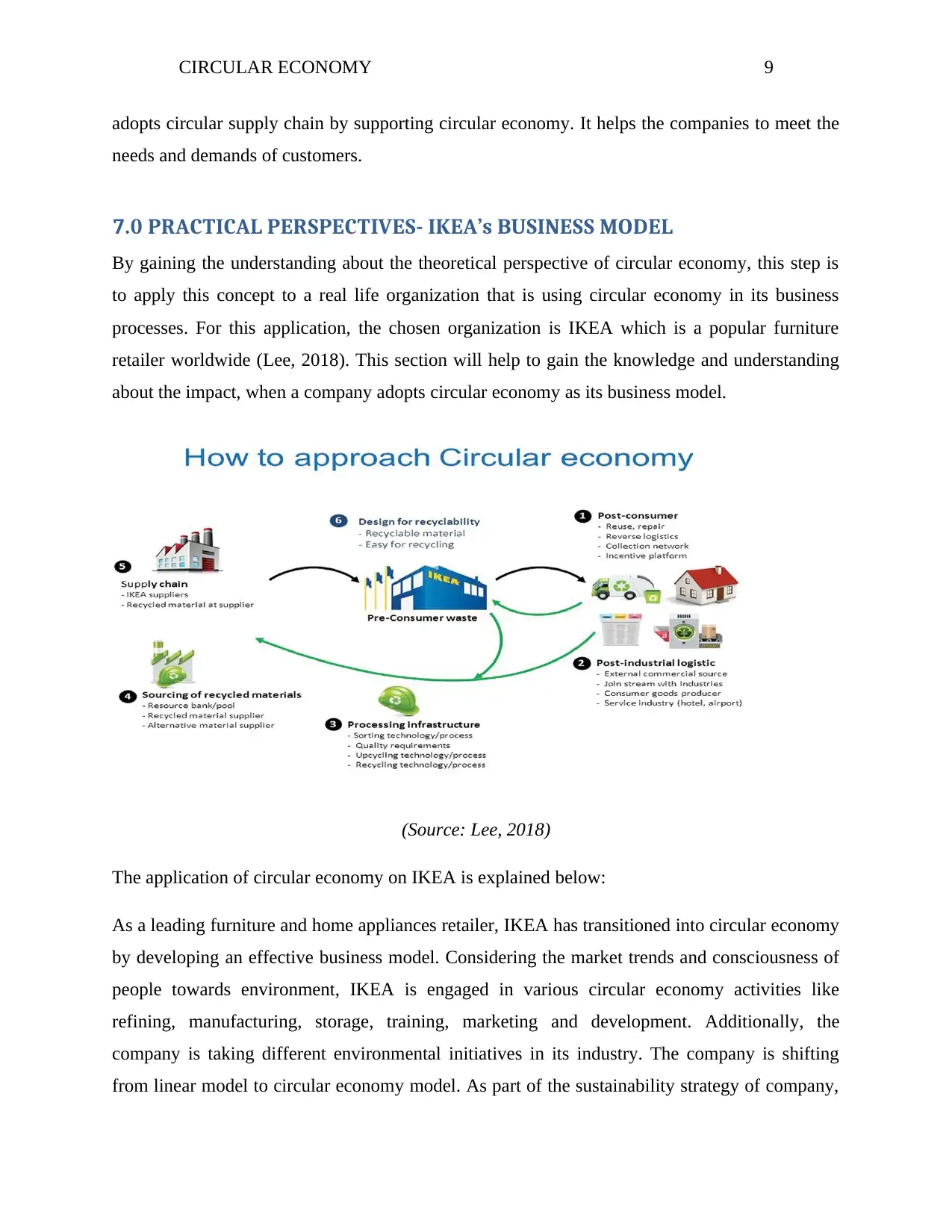
CIRCULAR ECONOMY 9
adopts circular supply chain by supporting circular economy. It helps the companies to meet the
needs and demands of customers.
7.0 PRACTICAL PERSPECTIVES- IKEA’s BUSINESS MODEL
By gaining the understanding about the theoretical perspective of circular economy, this step is
to apply this concept to a real life organization that is using circular economy in its business
processes. For this application, the chosen organization is IKEA which is a popular furniture
retailer worldwide (Lee, 2018). This section will help to gain the knowledge and understanding
about the impact, when a company adopts circular economy as its business model.
(Source: Lee, 2018)
The application of circular economy on IKEA is explained below:
As a leading furniture and home appliances retailer, IKEA has transitioned into circular economy
by developing an effective business model. Considering the market trends and consciousness of
people towards environment, IKEA is engaged in various circular economy activities like
refining, manufacturing, storage, training, marketing and development. Additionally, the
company is taking different environmental initiatives in its industry. The company is shifting
from linear model to circular economy model. As part of the sustainability strategy of company,
adopts circular supply chain by supporting circular economy. It helps the companies to meet the
needs and demands of customers.
7.0 PRACTICAL PERSPECTIVES- IKEA’s BUSINESS MODEL
By gaining the understanding about the theoretical perspective of circular economy, this step is
to apply this concept to a real life organization that is using circular economy in its business
processes. For this application, the chosen organization is IKEA which is a popular furniture
retailer worldwide (Lee, 2018). This section will help to gain the knowledge and understanding
about the impact, when a company adopts circular economy as its business model.
(Source: Lee, 2018)
The application of circular economy on IKEA is explained below:
As a leading furniture and home appliances retailer, IKEA has transitioned into circular economy
by developing an effective business model. Considering the market trends and consciousness of
people towards environment, IKEA is engaged in various circular economy activities like
refining, manufacturing, storage, training, marketing and development. Additionally, the
company is taking different environmental initiatives in its industry. The company is shifting
from linear model to circular economy model. As part of the sustainability strategy of company,
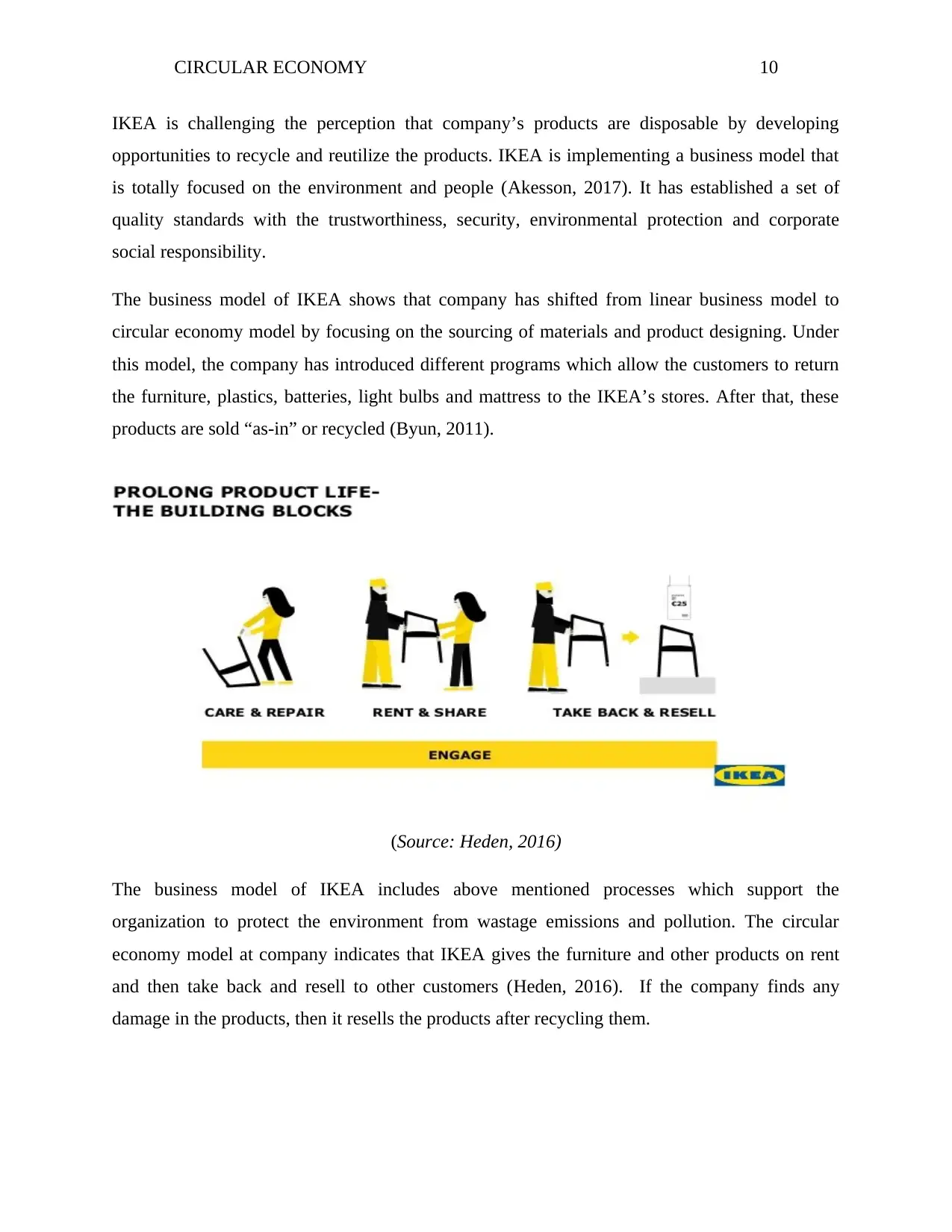
CIRCULAR ECONOMY 10
IKEA is challenging the perception that company’s products are disposable by developing
opportunities to recycle and reutilize the products. IKEA is implementing a business model that
is totally focused on the environment and people (Akesson, 2017). It has established a set of
quality standards with the trustworthiness, security, environmental protection and corporate
social responsibility.
The business model of IKEA shows that company has shifted from linear business model to
circular economy model by focusing on the sourcing of materials and product designing. Under
this model, the company has introduced different programs which allow the customers to return
the furniture, plastics, batteries, light bulbs and mattress to the IKEA’s stores. After that, these
products are sold “as-in” or recycled (Byun, 2011).
(Source: Heden, 2016)
The business model of IKEA includes above mentioned processes which support the
organization to protect the environment from wastage emissions and pollution. The circular
economy model at company indicates that IKEA gives the furniture and other products on rent
and then take back and resell to other customers (Heden, 2016). If the company finds any
damage in the products, then it resells the products after recycling them.
IKEA is challenging the perception that company’s products are disposable by developing
opportunities to recycle and reutilize the products. IKEA is implementing a business model that
is totally focused on the environment and people (Akesson, 2017). It has established a set of
quality standards with the trustworthiness, security, environmental protection and corporate
social responsibility.
The business model of IKEA shows that company has shifted from linear business model to
circular economy model by focusing on the sourcing of materials and product designing. Under
this model, the company has introduced different programs which allow the customers to return
the furniture, plastics, batteries, light bulbs and mattress to the IKEA’s stores. After that, these
products are sold “as-in” or recycled (Byun, 2011).
(Source: Heden, 2016)
The business model of IKEA includes above mentioned processes which support the
organization to protect the environment from wastage emissions and pollution. The circular
economy model at company indicates that IKEA gives the furniture and other products on rent
and then take back and resell to other customers (Heden, 2016). If the company finds any
damage in the products, then it resells the products after recycling them.
Secure Best Marks with AI Grader
Need help grading? Try our AI Grader for instant feedback on your assignments.
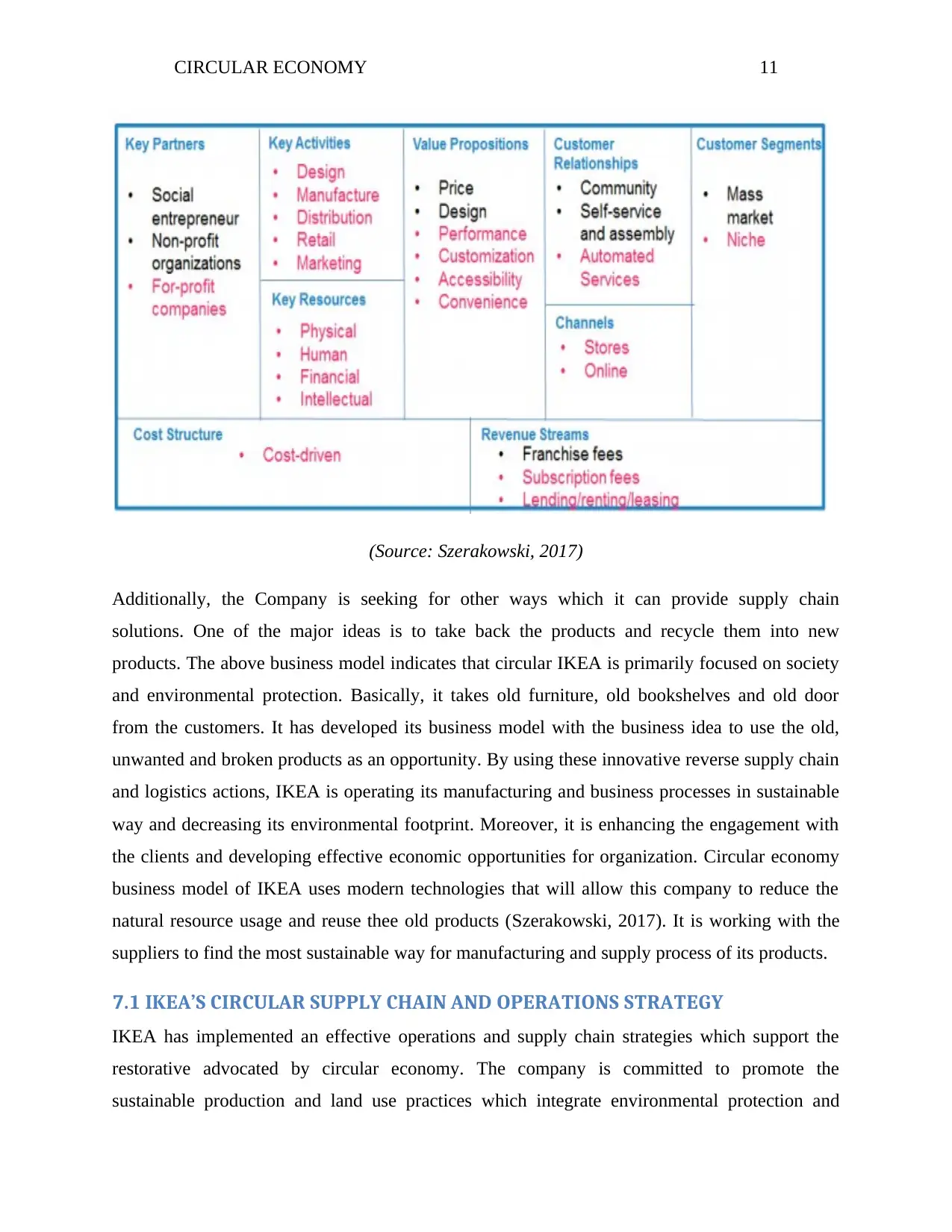
CIRCULAR ECONOMY 11
(Source: Szerakowski, 2017)
Additionally, the Company is seeking for other ways which it can provide supply chain
solutions. One of the major ideas is to take back the products and recycle them into new
products. The above business model indicates that circular IKEA is primarily focused on society
and environmental protection. Basically, it takes old furniture, old bookshelves and old door
from the customers. It has developed its business model with the business idea to use the old,
unwanted and broken products as an opportunity. By using these innovative reverse supply chain
and logistics actions, IKEA is operating its manufacturing and business processes in sustainable
way and decreasing its environmental footprint. Moreover, it is enhancing the engagement with
the clients and developing effective economic opportunities for organization. Circular economy
business model of IKEA uses modern technologies that will allow this company to reduce the
natural resource usage and reuse thee old products (Szerakowski, 2017). It is working with the
suppliers to find the most sustainable way for manufacturing and supply process of its products.
7.1 IKEA’S CIRCULAR SUPPLY CHAIN AND OPERATIONS STRATEGY
IKEA has implemented an effective operations and supply chain strategies which support the
restorative advocated by circular economy. The company is committed to promote the
sustainable production and land use practices which integrate environmental protection and
(Source: Szerakowski, 2017)
Additionally, the Company is seeking for other ways which it can provide supply chain
solutions. One of the major ideas is to take back the products and recycle them into new
products. The above business model indicates that circular IKEA is primarily focused on society
and environmental protection. Basically, it takes old furniture, old bookshelves and old door
from the customers. It has developed its business model with the business idea to use the old,
unwanted and broken products as an opportunity. By using these innovative reverse supply chain
and logistics actions, IKEA is operating its manufacturing and business processes in sustainable
way and decreasing its environmental footprint. Moreover, it is enhancing the engagement with
the clients and developing effective economic opportunities for organization. Circular economy
business model of IKEA uses modern technologies that will allow this company to reduce the
natural resource usage and reuse thee old products (Szerakowski, 2017). It is working with the
suppliers to find the most sustainable way for manufacturing and supply process of its products.
7.1 IKEA’S CIRCULAR SUPPLY CHAIN AND OPERATIONS STRATEGY
IKEA has implemented an effective operations and supply chain strategies which support the
restorative advocated by circular economy. The company is committed to promote the
sustainable production and land use practices which integrate environmental protection and
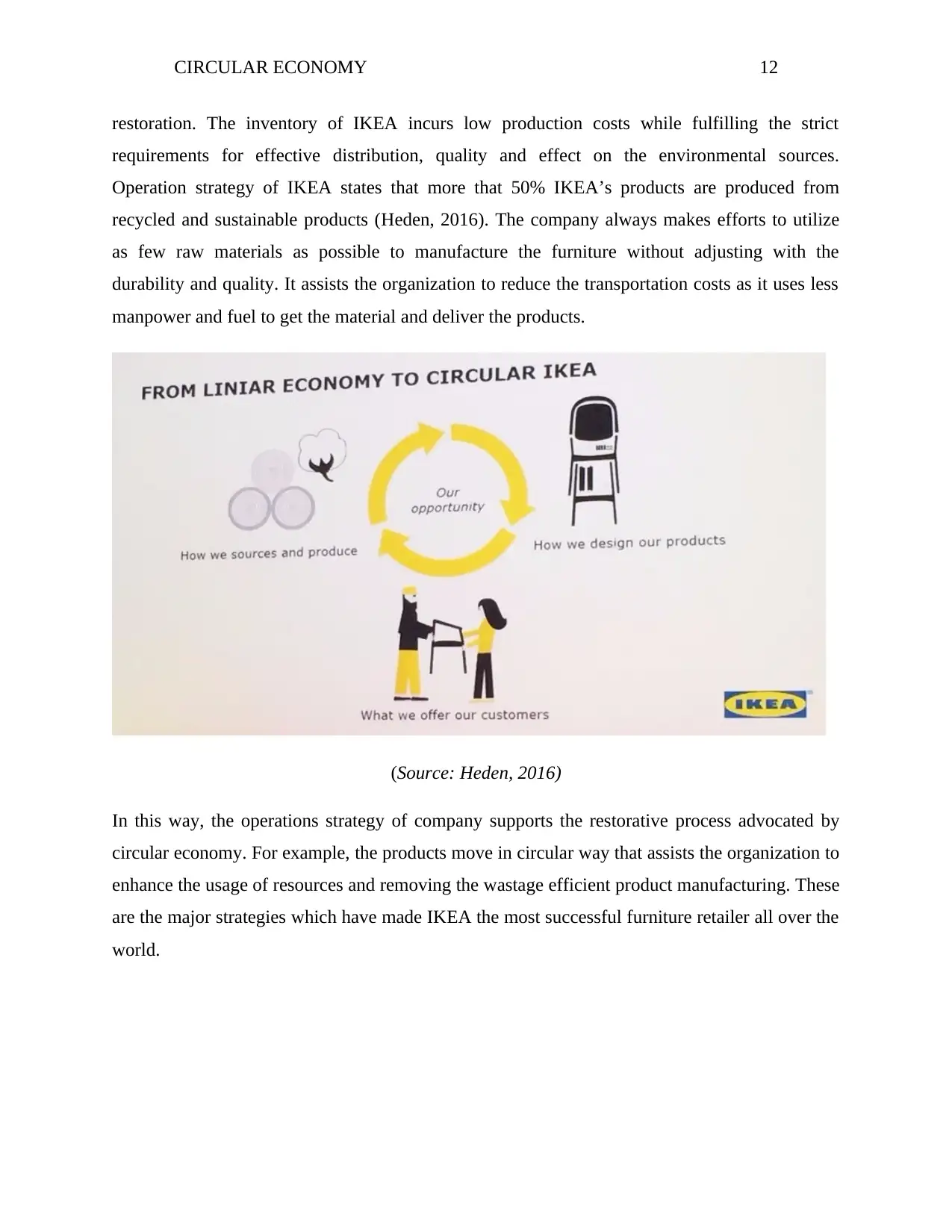
CIRCULAR ECONOMY 12
restoration. The inventory of IKEA incurs low production costs while fulfilling the strict
requirements for effective distribution, quality and effect on the environmental sources.
Operation strategy of IKEA states that more that 50% IKEA’s products are produced from
recycled and sustainable products (Heden, 2016). The company always makes efforts to utilize
as few raw materials as possible to manufacture the furniture without adjusting with the
durability and quality. It assists the organization to reduce the transportation costs as it uses less
manpower and fuel to get the material and deliver the products.
(Source: Heden, 2016)
In this way, the operations strategy of company supports the restorative process advocated by
circular economy. For example, the products move in circular way that assists the organization to
enhance the usage of resources and removing the wastage efficient product manufacturing. These
are the major strategies which have made IKEA the most successful furniture retailer all over the
world.
restoration. The inventory of IKEA incurs low production costs while fulfilling the strict
requirements for effective distribution, quality and effect on the environmental sources.
Operation strategy of IKEA states that more that 50% IKEA’s products are produced from
recycled and sustainable products (Heden, 2016). The company always makes efforts to utilize
as few raw materials as possible to manufacture the furniture without adjusting with the
durability and quality. It assists the organization to reduce the transportation costs as it uses less
manpower and fuel to get the material and deliver the products.
(Source: Heden, 2016)
In this way, the operations strategy of company supports the restorative process advocated by
circular economy. For example, the products move in circular way that assists the organization to
enhance the usage of resources and removing the wastage efficient product manufacturing. These
are the major strategies which have made IKEA the most successful furniture retailer all over the
world.
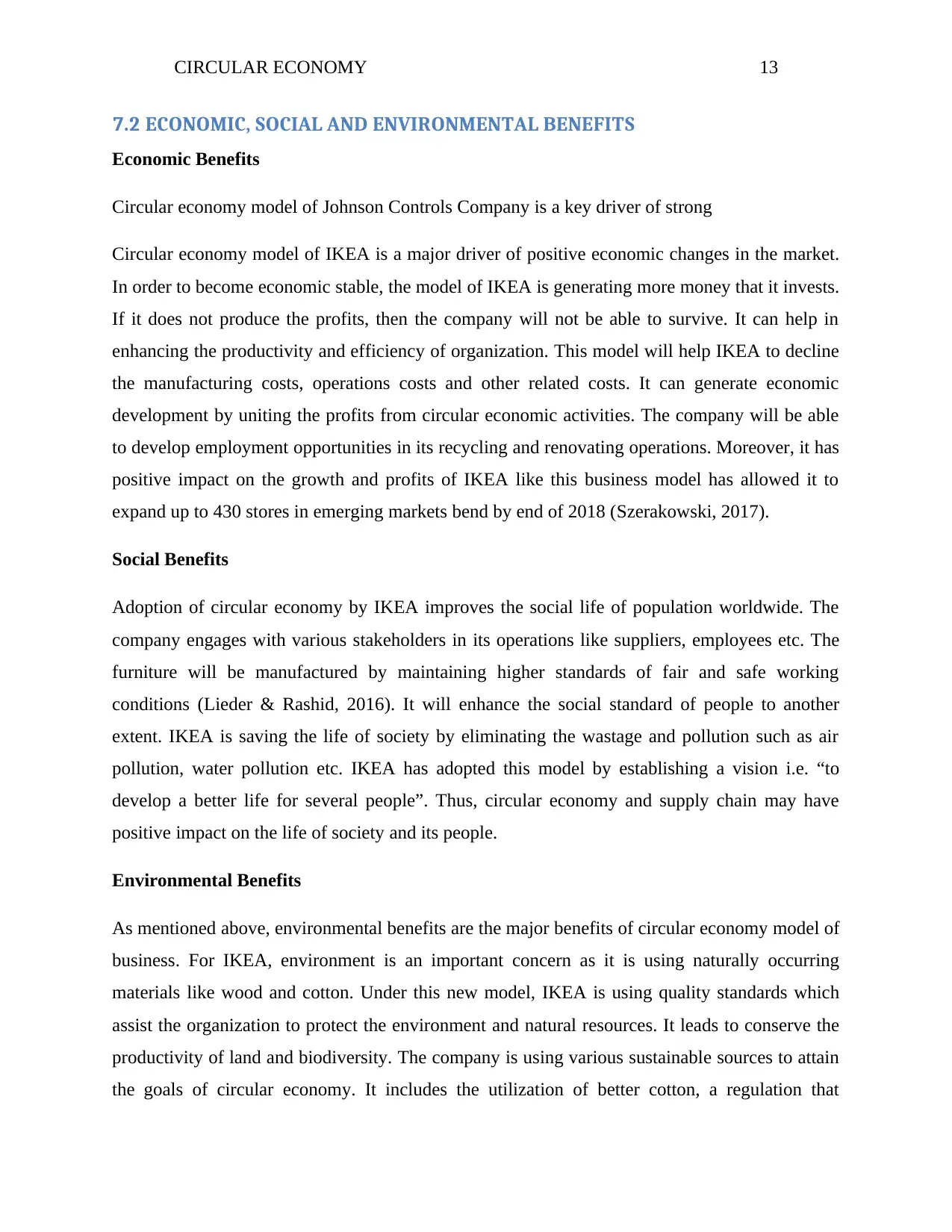
CIRCULAR ECONOMY 13
7.2 ECONOMIC, SOCIAL AND ENVIRONMENTAL BENEFITS
Economic Benefits
Circular economy model of Johnson Controls Company is a key driver of strong
Circular economy model of IKEA is a major driver of positive economic changes in the market.
In order to become economic stable, the model of IKEA is generating more money that it invests.
If it does not produce the profits, then the company will not be able to survive. It can help in
enhancing the productivity and efficiency of organization. This model will help IKEA to decline
the manufacturing costs, operations costs and other related costs. It can generate economic
development by uniting the profits from circular economic activities. The company will be able
to develop employment opportunities in its recycling and renovating operations. Moreover, it has
positive impact on the growth and profits of IKEA like this business model has allowed it to
expand up to 430 stores in emerging markets bend by end of 2018 (Szerakowski, 2017).
Social Benefits
Adoption of circular economy by IKEA improves the social life of population worldwide. The
company engages with various stakeholders in its operations like suppliers, employees etc. The
furniture will be manufactured by maintaining higher standards of fair and safe working
conditions (Lieder & Rashid, 2016). It will enhance the social standard of people to another
extent. IKEA is saving the life of society by eliminating the wastage and pollution such as air
pollution, water pollution etc. IKEA has adopted this model by establishing a vision i.e. “to
develop a better life for several people”. Thus, circular economy and supply chain may have
positive impact on the life of society and its people.
Environmental Benefits
As mentioned above, environmental benefits are the major benefits of circular economy model of
business. For IKEA, environment is an important concern as it is using naturally occurring
materials like wood and cotton. Under this new model, IKEA is using quality standards which
assist the organization to protect the environment and natural resources. It leads to conserve the
productivity of land and biodiversity. The company is using various sustainable sources to attain
the goals of circular economy. It includes the utilization of better cotton, a regulation that
7.2 ECONOMIC, SOCIAL AND ENVIRONMENTAL BENEFITS
Economic Benefits
Circular economy model of Johnson Controls Company is a key driver of strong
Circular economy model of IKEA is a major driver of positive economic changes in the market.
In order to become economic stable, the model of IKEA is generating more money that it invests.
If it does not produce the profits, then the company will not be able to survive. It can help in
enhancing the productivity and efficiency of organization. This model will help IKEA to decline
the manufacturing costs, operations costs and other related costs. It can generate economic
development by uniting the profits from circular economic activities. The company will be able
to develop employment opportunities in its recycling and renovating operations. Moreover, it has
positive impact on the growth and profits of IKEA like this business model has allowed it to
expand up to 430 stores in emerging markets bend by end of 2018 (Szerakowski, 2017).
Social Benefits
Adoption of circular economy by IKEA improves the social life of population worldwide. The
company engages with various stakeholders in its operations like suppliers, employees etc. The
furniture will be manufactured by maintaining higher standards of fair and safe working
conditions (Lieder & Rashid, 2016). It will enhance the social standard of people to another
extent. IKEA is saving the life of society by eliminating the wastage and pollution such as air
pollution, water pollution etc. IKEA has adopted this model by establishing a vision i.e. “to
develop a better life for several people”. Thus, circular economy and supply chain may have
positive impact on the life of society and its people.
Environmental Benefits
As mentioned above, environmental benefits are the major benefits of circular economy model of
business. For IKEA, environment is an important concern as it is using naturally occurring
materials like wood and cotton. Under this new model, IKEA is using quality standards which
assist the organization to protect the environment and natural resources. It leads to conserve the
productivity of land and biodiversity. The company is using various sustainable sources to attain
the goals of circular economy. It includes the utilization of better cotton, a regulation that
Paraphrase This Document
Need a fresh take? Get an instant paraphrase of this document with our AI Paraphraser
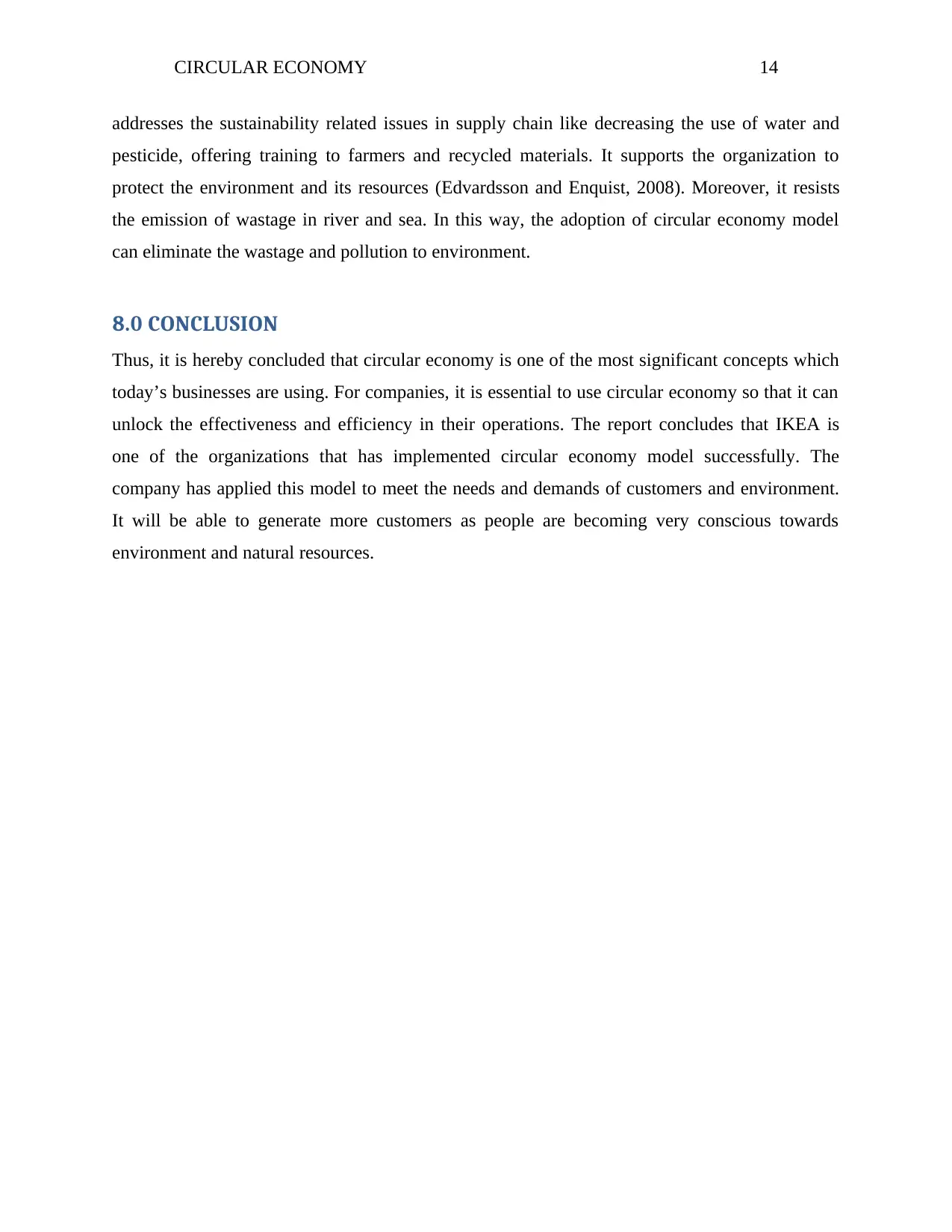
CIRCULAR ECONOMY 14
addresses the sustainability related issues in supply chain like decreasing the use of water and
pesticide, offering training to farmers and recycled materials. It supports the organization to
protect the environment and its resources (Edvardsson and Enquist, 2008). Moreover, it resists
the emission of wastage in river and sea. In this way, the adoption of circular economy model
can eliminate the wastage and pollution to environment.
8.0 CONCLUSION
Thus, it is hereby concluded that circular economy is one of the most significant concepts which
today’s businesses are using. For companies, it is essential to use circular economy so that it can
unlock the effectiveness and efficiency in their operations. The report concludes that IKEA is
one of the organizations that has implemented circular economy model successfully. The
company has applied this model to meet the needs and demands of customers and environment.
It will be able to generate more customers as people are becoming very conscious towards
environment and natural resources.
addresses the sustainability related issues in supply chain like decreasing the use of water and
pesticide, offering training to farmers and recycled materials. It supports the organization to
protect the environment and its resources (Edvardsson and Enquist, 2008). Moreover, it resists
the emission of wastage in river and sea. In this way, the adoption of circular economy model
can eliminate the wastage and pollution to environment.
8.0 CONCLUSION
Thus, it is hereby concluded that circular economy is one of the most significant concepts which
today’s businesses are using. For companies, it is essential to use circular economy so that it can
unlock the effectiveness and efficiency in their operations. The report concludes that IKEA is
one of the organizations that has implemented circular economy model successfully. The
company has applied this model to meet the needs and demands of customers and environment.
It will be able to generate more customers as people are becoming very conscious towards
environment and natural resources.
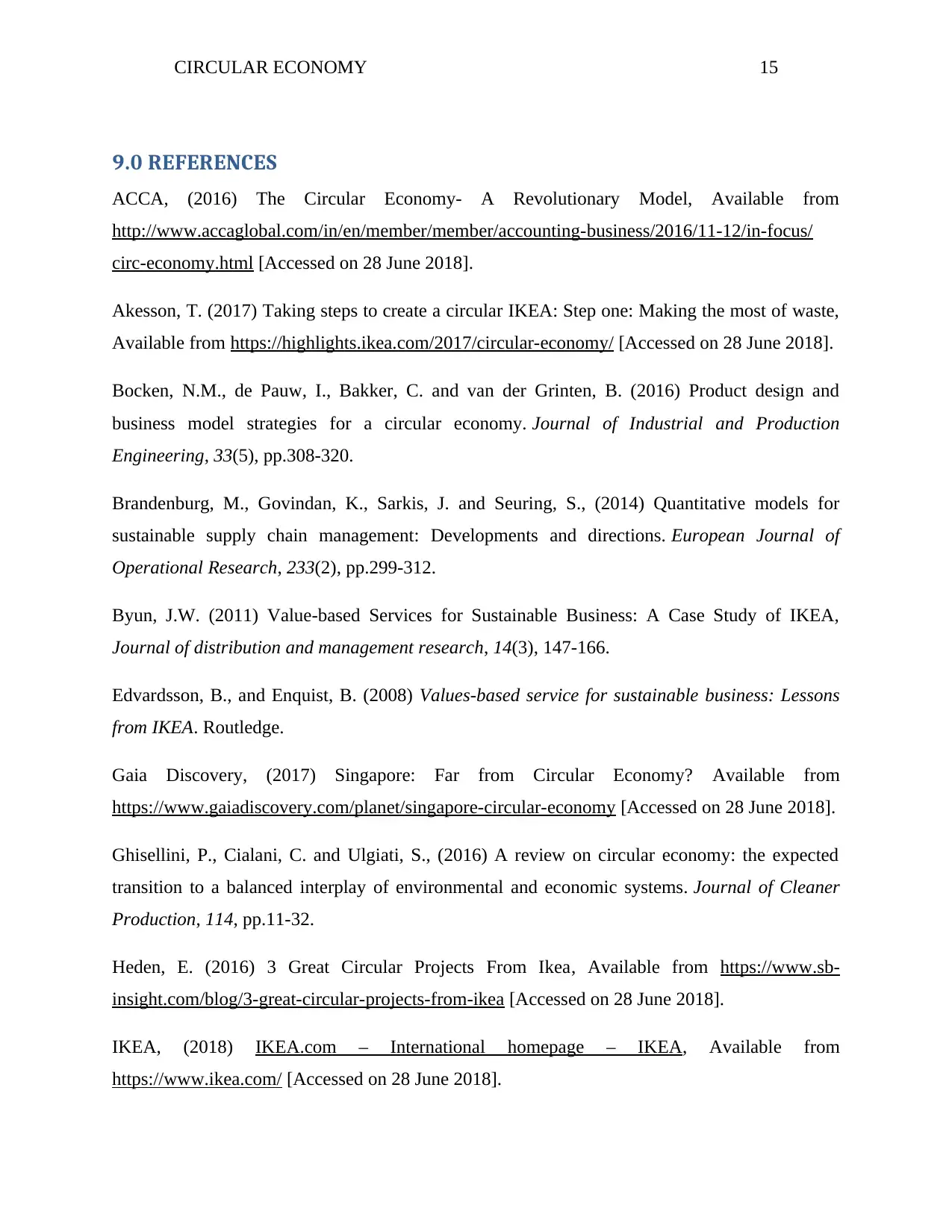
CIRCULAR ECONOMY 15
9.0 REFERENCES
ACCA, (2016) The Circular Economy- A Revolutionary Model, Available from
http://www.accaglobal.com/in/en/member/member/accounting-business/2016/11-12/in-focus/
circ-economy.html [Accessed on 28 June 2018].
Akesson, T. (2017) Taking steps to create a circular IKEA: Step one: Making the most of waste,
Available from https://highlights.ikea.com/2017/circular-economy/ [Accessed on 28 June 2018].
Bocken, N.M., de Pauw, I., Bakker, C. and van der Grinten, B. (2016) Product design and
business model strategies for a circular economy. Journal of Industrial and Production
Engineering, 33(5), pp.308-320.
Brandenburg, M., Govindan, K., Sarkis, J. and Seuring, S., (2014) Quantitative models for
sustainable supply chain management: Developments and directions. European Journal of
Operational Research, 233(2), pp.299-312.
Byun, J.W. (2011) Value-based Services for Sustainable Business: A Case Study of IKEA,
Journal of distribution and management research, 14(3), 147-166.
Edvardsson, B., and Enquist, B. (2008) Values-based service for sustainable business: Lessons
from IKEA. Routledge.
Gaia Discovery, (2017) Singapore: Far from Circular Economy? Available from
https://www.gaiadiscovery.com/planet/singapore-circular-economy [Accessed on 28 June 2018].
Ghisellini, P., Cialani, C. and Ulgiati, S., (2016) A review on circular economy: the expected
transition to a balanced interplay of environmental and economic systems. Journal of Cleaner
Production, 114, pp.11-32.
Heden, E. (2016) 3 Great Circular Projects From Ikea, Available from https://www.sb-
insight.com/blog/3-great-circular-projects-from-ikea [Accessed on 28 June 2018].
IKEA, (2018) IKEA.com – International homepage – IKEA, Available from
https://www.ikea.com/ [Accessed on 28 June 2018].
9.0 REFERENCES
ACCA, (2016) The Circular Economy- A Revolutionary Model, Available from
http://www.accaglobal.com/in/en/member/member/accounting-business/2016/11-12/in-focus/
circ-economy.html [Accessed on 28 June 2018].
Akesson, T. (2017) Taking steps to create a circular IKEA: Step one: Making the most of waste,
Available from https://highlights.ikea.com/2017/circular-economy/ [Accessed on 28 June 2018].
Bocken, N.M., de Pauw, I., Bakker, C. and van der Grinten, B. (2016) Product design and
business model strategies for a circular economy. Journal of Industrial and Production
Engineering, 33(5), pp.308-320.
Brandenburg, M., Govindan, K., Sarkis, J. and Seuring, S., (2014) Quantitative models for
sustainable supply chain management: Developments and directions. European Journal of
Operational Research, 233(2), pp.299-312.
Byun, J.W. (2011) Value-based Services for Sustainable Business: A Case Study of IKEA,
Journal of distribution and management research, 14(3), 147-166.
Edvardsson, B., and Enquist, B. (2008) Values-based service for sustainable business: Lessons
from IKEA. Routledge.
Gaia Discovery, (2017) Singapore: Far from Circular Economy? Available from
https://www.gaiadiscovery.com/planet/singapore-circular-economy [Accessed on 28 June 2018].
Ghisellini, P., Cialani, C. and Ulgiati, S., (2016) A review on circular economy: the expected
transition to a balanced interplay of environmental and economic systems. Journal of Cleaner
Production, 114, pp.11-32.
Heden, E. (2016) 3 Great Circular Projects From Ikea, Available from https://www.sb-
insight.com/blog/3-great-circular-projects-from-ikea [Accessed on 28 June 2018].
IKEA, (2018) IKEA.com – International homepage – IKEA, Available from
https://www.ikea.com/ [Accessed on 28 June 2018].
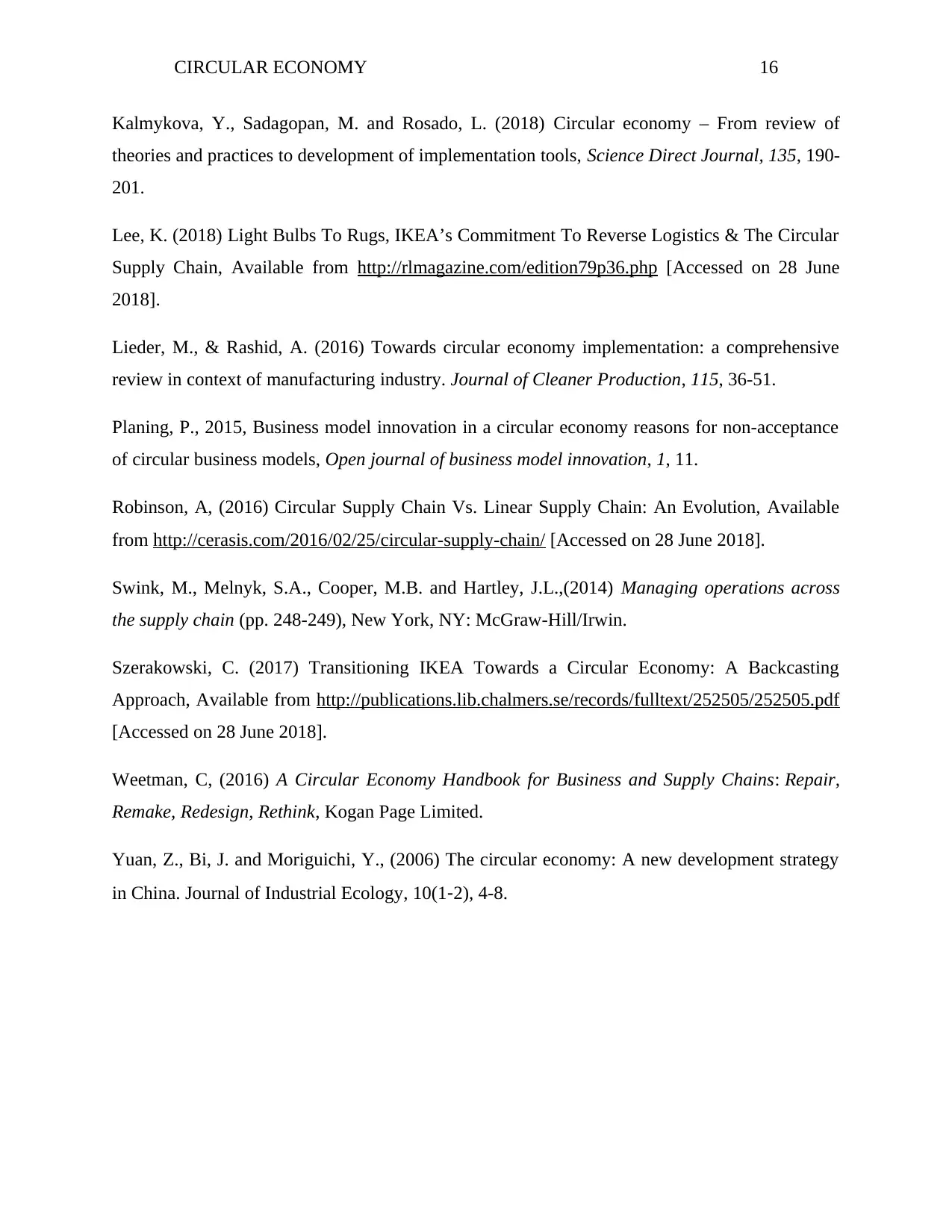
CIRCULAR ECONOMY 16
Kalmykova, Y., Sadagopan, M. and Rosado, L. (2018) Circular economy – From review of
theories and practices to development of implementation tools, Science Direct Journal, 135, 190-
201.
Lee, K. (2018) Light Bulbs To Rugs, IKEA’s Commitment To Reverse Logistics & The Circular
Supply Chain, Available from http://rlmagazine.com/edition79p36.php [Accessed on 28 June
2018].
Lieder, M., & Rashid, A. (2016) Towards circular economy implementation: a comprehensive
review in context of manufacturing industry. Journal of Cleaner Production, 115, 36-51.
Planing, P., 2015, Business model innovation in a circular economy reasons for non-acceptance
of circular business models, Open journal of business model innovation, 1, 11.
Robinson, A, (2016) Circular Supply Chain Vs. Linear Supply Chain: An Evolution, Available
from http://cerasis.com/2016/02/25/circular-supply-chain/ [Accessed on 28 June 2018].
Swink, M., Melnyk, S.A., Cooper, M.B. and Hartley, J.L.,(2014) Managing operations across
the supply chain (pp. 248-249), New York, NY: McGraw-Hill/Irwin.
Szerakowski, C. (2017) Transitioning IKEA Towards a Circular Economy: A Backcasting
Approach, Available from http://publications.lib.chalmers.se/records/fulltext/252505/252505.pdf
[Accessed on 28 June 2018].
Weetman, C, (2016) A Circular Economy Handbook for Business and Supply Chains: Repair,
Remake, Redesign, Rethink, Kogan Page Limited.
Yuan, Z., Bi, J. and Moriguichi, Y., (2006) The circular economy: A new development strategy
in China. Journal of Industrial Ecology, 10(1‐2), 4-8.
Kalmykova, Y., Sadagopan, M. and Rosado, L. (2018) Circular economy – From review of
theories and practices to development of implementation tools, Science Direct Journal, 135, 190-
201.
Lee, K. (2018) Light Bulbs To Rugs, IKEA’s Commitment To Reverse Logistics & The Circular
Supply Chain, Available from http://rlmagazine.com/edition79p36.php [Accessed on 28 June
2018].
Lieder, M., & Rashid, A. (2016) Towards circular economy implementation: a comprehensive
review in context of manufacturing industry. Journal of Cleaner Production, 115, 36-51.
Planing, P., 2015, Business model innovation in a circular economy reasons for non-acceptance
of circular business models, Open journal of business model innovation, 1, 11.
Robinson, A, (2016) Circular Supply Chain Vs. Linear Supply Chain: An Evolution, Available
from http://cerasis.com/2016/02/25/circular-supply-chain/ [Accessed on 28 June 2018].
Swink, M., Melnyk, S.A., Cooper, M.B. and Hartley, J.L.,(2014) Managing operations across
the supply chain (pp. 248-249), New York, NY: McGraw-Hill/Irwin.
Szerakowski, C. (2017) Transitioning IKEA Towards a Circular Economy: A Backcasting
Approach, Available from http://publications.lib.chalmers.se/records/fulltext/252505/252505.pdf
[Accessed on 28 June 2018].
Weetman, C, (2016) A Circular Economy Handbook for Business and Supply Chains: Repair,
Remake, Redesign, Rethink, Kogan Page Limited.
Yuan, Z., Bi, J. and Moriguichi, Y., (2006) The circular economy: A new development strategy
in China. Journal of Industrial Ecology, 10(1‐2), 4-8.
Secure Best Marks with AI Grader
Need help grading? Try our AI Grader for instant feedback on your assignments.
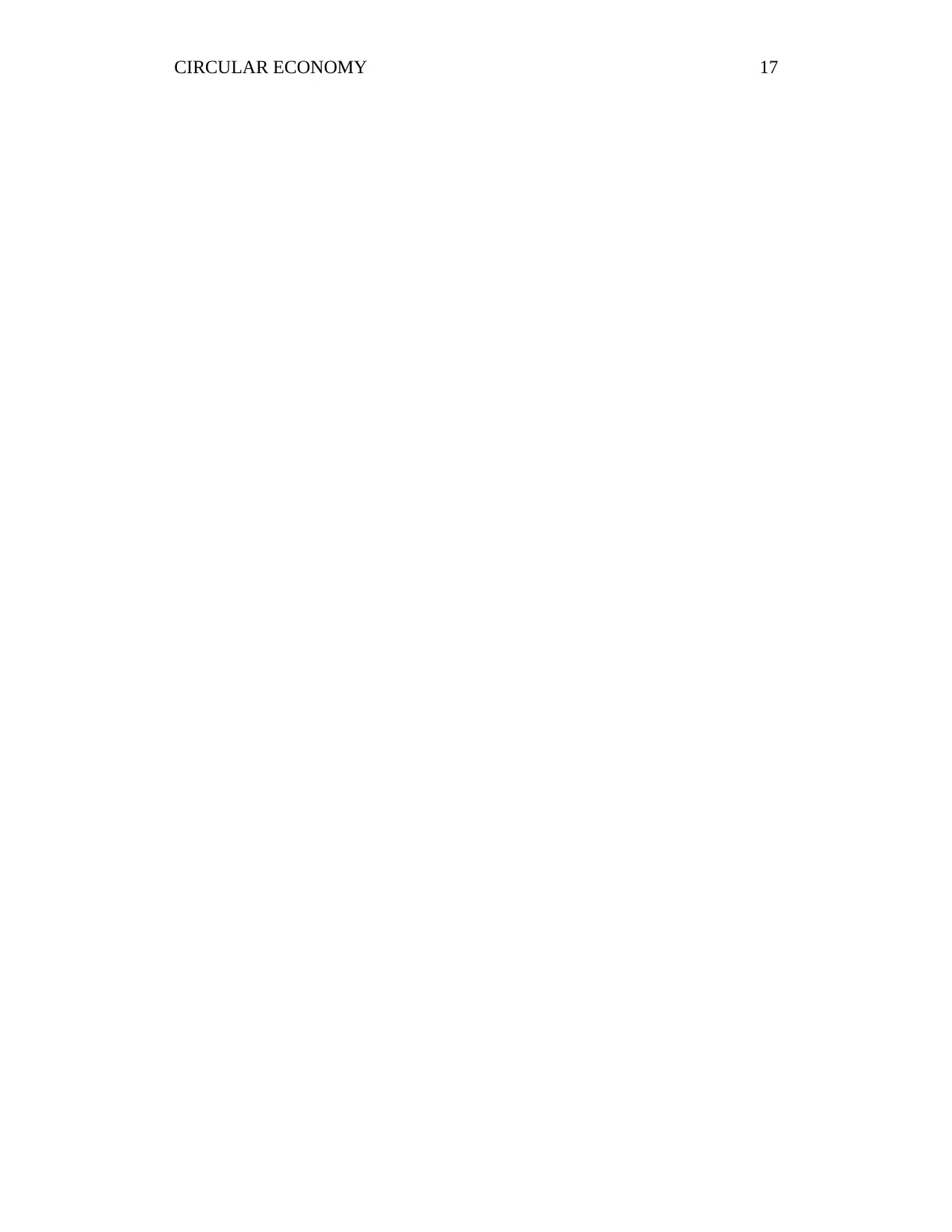
CIRCULAR ECONOMY 17
1 out of 17
Related Documents
Your All-in-One AI-Powered Toolkit for Academic Success.
+13062052269
info@desklib.com
Available 24*7 on WhatsApp / Email
![[object Object]](/_next/static/media/star-bottom.7253800d.svg)
Unlock your academic potential
© 2024 | Zucol Services PVT LTD | All rights reserved.




